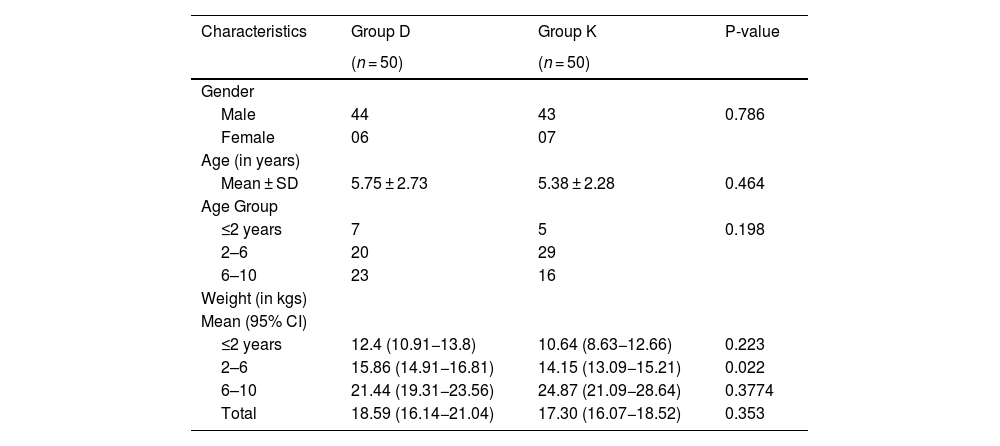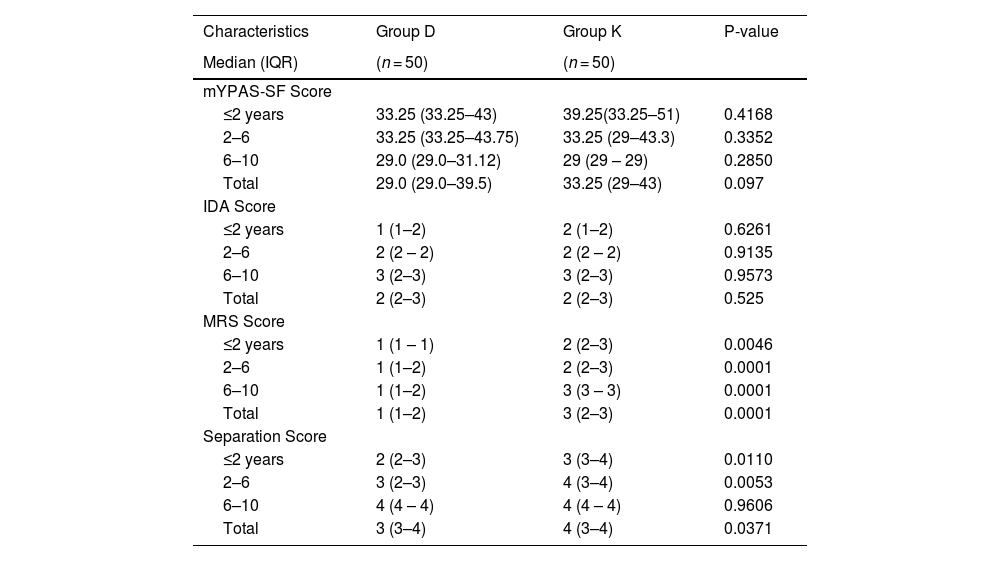Paediatric patients are given premedication in order to decrease preoperative anxiety, allow smooth induction, and prevent postoperative psychological insult and behavioural changes. A child friendly method of administration is desirable.
We compared intranasal administration of dexmedetomidine and ketamine in the operating room environment, to evaluate the Faces, Legs, Activity, Cry and Consolability (FLACC) score at the time of establishing intravenous access for induction of general anaesthesia.
MethodsThis prospective, double-blind, randomized controlled trial was conducted at a tertiary care center. One hundred patients, 2–10 years of age, ASA physical status 1 & 2, scheduled for general anaesthesia were enrolled. Patient’s presedation behaviour was assessed by the modified Yale Preoperative Anxiety Scale Short Form (mYPAS-SF). Patients in Group D received Dexmedetomidine 1 mcg/kg intranasally, and patients in Group K received Ketamine 5 mg/kg intranasally. After 45 min, patients were transferred to the operating table where intravenous cannulation was carried out and the response to needle insertion was assessed by FLACC scale. Vital signs, including the pulse-oximetry, heart rate and respiratory rate were monitored. Side effects such as nausea, vomiting, and agitation were also recorded.
ResultsA significantly higher FLACC score was seen in Group D as compared to Group K (p = 0.001). The mean heart rate between two groups was found to be significantly (p = 0.001) lower in Group D compared to Group K. However, the proportion of adverse events was 8% in patients who received ketamine.
ConclusionsIntranasal ketamine in a dose of 5 mg/kg is clinically more effective as premedication in children aged 2–10 years in comparison with intranasal dexmedetomidine in a dose of 1 mcg/kg.
Los pacientes pediátricos reciben premedicación para reducir la ansiedad preoperatoria, permitir una inducción suave, y prevenir la agresión psicológica postoperatorio y los cambios conductuales. Por tanto, es necesario un método de administración agradable para los niños.
Administramos la escala FLACC (Faces, Legs, Activity, Cry and Consolability) a los pacientes que recibieron dexmedetomidina y ketamina intranasal, para comparar sus reacciones a la inserción de un catéter para inducción de anestesia general en el quirófano.
MétodosEste ensayo controlado aleatorizado prospectivo y doble ciego fue realizado en un centro de atención terciario, incorporando a cien pacientes de 2 a 10 años de edad, con estado físico ASA 1 y 2, programados para anestesia general. Se evaluó el comportamiento previo a la sedación utilizando el formulario modificado mYPAS-SF (Yale Preoperative Anxiety Scale Short Form). Los pacientes del Grupo D recibieron 1 mcg/kg de dexmedetomidina, y los pacientes del Grupo K 5 mg/kg de ketamina, intranasalmente. Transcurridos 45 minutos, los pacientes fueron trasladados al quirófano, realizándose en la camilla canulación intravenosa, y evaluándose la respuesta del paciente a la inserción de la aguja mediante la escala FLACC. Se monitorizaron los signos vitales, incluyendo frecuencia cardiaca, frecuencia respiratoria y niveles de oxígeno arterial. También se registraron los efectos secundarios tales como náuseas, vómitos y agitación.
ResultadosLa puntuación FLACC fue significativamente más alta en el Grupo D frente al Grupo K (p = 0,001). La frecuencia cardiaca media fue significativamente más baja (p = 0,001) en el Grupo D frente al Grupo K. Sin embargo, se produjeron efectos adversos en el 8% de los pacientes que recibieron ketamina.
ConclusionesLa administración de ketamina intranasal a una dosis de 5 mg/kg es clínicamente más efectiva para premedicación en los niños de 2 a 10 años de edad, en comparación con dexmedetomidina intranasal a una dosis de 1 mcg/kg.












